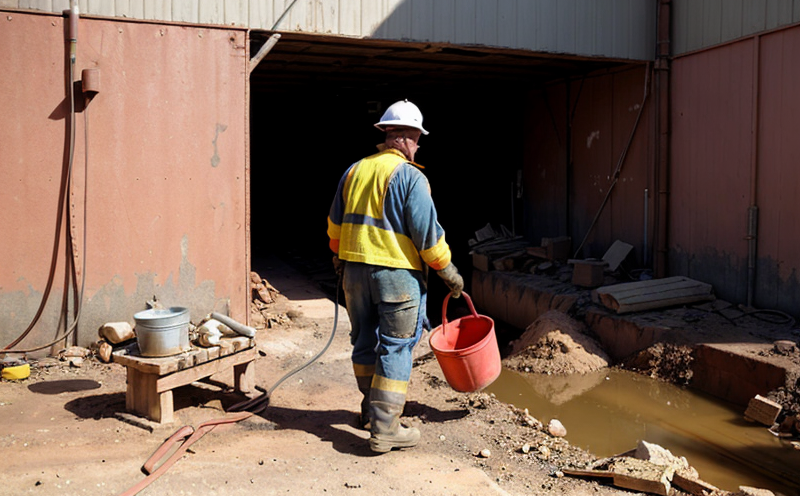OSHA ID 142 Respirable Crystalline Silica Compliance Testing
The Occupational Safety and Health Administration (OSHA) has a strict regulatory framework for industries involving respirable crystalline silica due to its potential health hazards. Mine safety, in particular, is a critical area where compliance with OSHA standards is non-negotiable. The Respirable Crystalline Silica Compliance Testing under OSHA ID 142 ensures that mining operations meet the stringent requirements laid out by OSHA to protect workers from silica-related illnesses.
The respirable crystalline silica testing aims to assess the levels of respirable dust containing crystalline silica in mine environments. This is critical because exposure to high concentrations of this dust can lead to serious lung diseases like silicosis, a debilitating condition that results in progressive scarring of the lungs and difficulty breathing.
The OSHA ID 142 test involves several key steps which include air sampling using a suitable method such as the TSI Dust Trak or similar device. This step is crucial for capturing particles smaller than 10 micrometers, ensuring accurate measurement of respirable dust containing crystalline silica. The collected samples are then analyzed in our state-of-the-art laboratory to determine their concentration.
Our testing method adheres strictly to the guidelines set forth by OSHA and NIOSH (National Institute for Occupational Safety and Health). These include the use of appropriate sampling techniques, proper handling of hazardous materials, and rigorous quality assurance measures. The results are reported in parts per million (ppm) or micrograms per cubic meter (µg/m³), which is a standard unit used by OSHA to evaluate compliance.
The importance of this testing cannot be overstated. It serves as the cornerstone for mine safety protocols, ensuring that workers are not exposed to hazardous levels of respirable crystalline silica. Compliance with these standards is mandatory under OSHA Standard 1926.55 and 1926.110, which require employers to implement engineering controls and medical surveillance programs.
The testing process involves multiple steps, each critical for accurate results:
- Air Sampling: Utilizing specialized equipment to collect dust samples from various points in the mine environment.
- Sampling Media: Collecting dust on appropriate media such as quartz-free filter membranes.
- Digestion and Analysis: Digesting the collected dust using acid digestion methods followed by analysis for silica content.
The use of advanced instrumentation like ICP-MS (Inductively Coupled Plasma Mass Spectrometry) ensures precision and accuracy in our measurements. This not only helps in meeting regulatory requirements but also supports continuous improvement efforts within the mining industry.
In summary, OSHA ID 142 Respirable Crystalline Silica Compliance Testing is essential for ensuring worker safety in mines. By adhering to these stringent standards, we contribute significantly towards reducing respiratory diseases caused by silica exposure and maintaining a safe work environment.
Industry Applications
The OSHA ID 142 Respirable Crystalline Silica Compliance Testing is particularly relevant to several industries, including mining. Here are some key applications:
| Industry | Main Application |
|---|---|
| Mining | Evaluation of respirable dust levels in various mine environments. |
| Petrochemicals | Dust monitoring in storage and processing facilities. |
| Construction | Monitoring air quality during demolition activities involving silica-containing materials. |
| Manufacturing | Assessment of airborne dust levels in production areas using silica-containing raw materials. |
The testing is also applicable to other sectors where respirable crystalline silica might be present, such as foundries and glass manufacturing. In these industries, the testing helps identify potential exposure risks early on, allowing for timely interventions to mitigate hazards.
- Mining: Ensures compliance with OSHA standards and protects miners from silicosis.
- Petrochemicals: Helps in maintaining safe work environments by monitoring dust levels.
- Construction: Supports safety protocols during activities involving silica-containing materials.
The testing plays a vital role in maintaining occupational health and safety, ensuring that workers are not exposed to hazardous levels of respirable crystalline silica.
EuroLab Advantages
At EuroLab, we pride ourselves on providing comprehensive and reliable testing services for OSHA ID 142. Our advantages include:
- Expertise: Our team of experts has extensive experience in conducting such tests, ensuring accuracy and reliability.
- State-of-the-Art Facilities: Equipped with the latest technology and instrumentation to provide precise results.
- Compliance: Adherence to all relevant international standards including OSHA and NIOSH guidelines.
- Quality Assurance: Rigorous quality control measures to ensure consistent and accurate testing results.
We understand the critical nature of this testing, which is why we offer a range of services tailored to meet your specific needs. Our commitment to excellence ensures that you receive reliable data that can be used for making informed decisions about worker safety and health.
Our expertise extends beyond just conducting tests; it includes providing recommendations on how best to manage silica exposure in the workplace, ensuring compliance with all relevant regulations.
International Acceptance and Recognition
The OSHA ID 142 Respirable Crystalline Silica Compliance Testing is widely recognized both nationally and internationally for its stringent standards. Here are the key points regarding its acceptance:
- OSHA Standards: The testing method strictly follows OSHA Standard 1926.55 and 1926.110.
- NIOSH Guidelines: Adherence to NIOSH protocols ensures reliability and accuracy.
- ISO/IEC Standards: Our testing methods align with ISO/IEC standards for quality assurance, ensuring consistency and precision.
| Countries Recognizing the Test | Main Regulatory Bodies |
|---|---|
| USA (OSHA) | Occupational Safety and Health Administration (OSHA) |
| Canada (OHSA) | Canadian Standards Association (CSA) |
| EU (Member States) | National Authorities |
The global recognition of this testing underscores its importance in maintaining occupational safety and health standards. By adhering to these recognized methods, we ensure that your mine complies with international best practices.
Our commitment to excellence is reflected not only in our testing services but also in our adherence to the highest international standards. This ensures that you receive reliable data that can be used for making informed decisions about worker safety and health.





